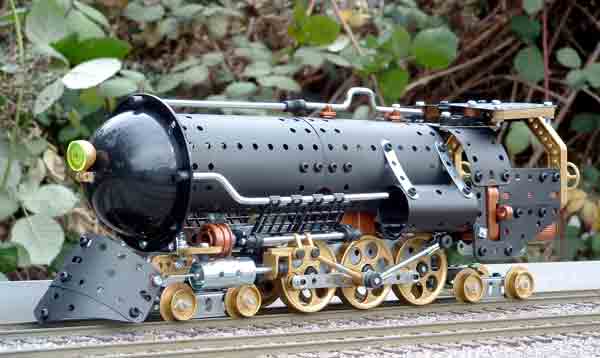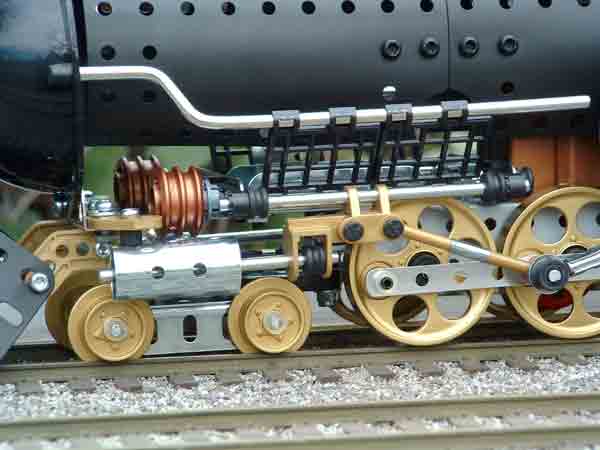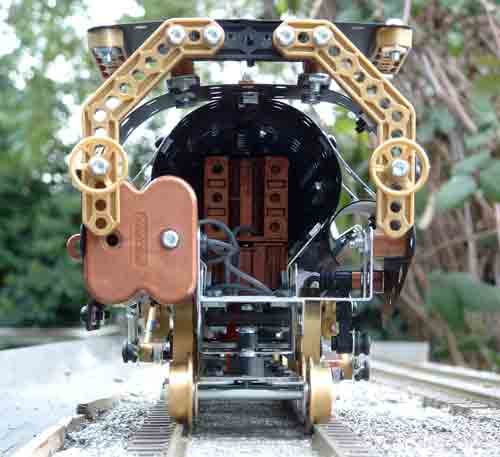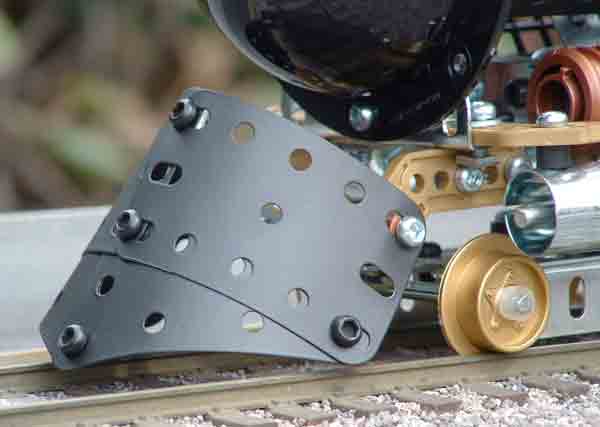Meccano
363 Avenue de Saint Exupery
F-62100 Calais
France
Price: $65.99 at Toys-R-Us
Website: www.meccano.com
Erector Special Edition #83-0506E, non-scale-specific construction set for a couple of different 1-gauge locomotives (as well as a rocket, submarine, or four other vehicles); all necessary parts with instruction booklet included (except 4 AA batteries); 530 parts; recommended age 8 to 15 years. Dimensions: overall length, typically 15″; width, 4½”; height 6½”
Pros: Overall appealing impression; cool retro look; great learning experience for adult-and-young-child activity
Cons: Wheelsets and linkage system not robust; some parts modification or substitution not included in the kit necessary for extended track operation; a few more extra nuts and bolts would be helpful
Erector brand is now owned by Meccano, a French company, but they have retained the essence of the original sets while adding some new pieces and specialty shapes. The set we decided to build was the electric, battery-powered steam engine (of course). The overall look of the model is reminiscent of Jules Verne. Amazingly, the model is designed for gauge-1 track, so it seemed the perfect project. This is an excellent father/child (or grandfather/grandchild project—girls not excluded here).
There are a lot of parts. We started by laying them out, sorting them by type (different screw lengths, axle lengths, etc.), and using the compartments in the case to group them for quick identification.
For the first couple of steps (there were 27, all told), Max and I just read the directions, looked for the parts, and assembled them. Then we tried a more efficient approach. I had Max read the next numbered direction and gather the parts together in a “next up” bin, while I assembled the parts in the current step. This was good exercise for him in locating and identifying parts by shape, description and color. We did that for a few steps, then switched places once he had the hang of assembly from watching me. In this way he got experience in both learning the different parts and assembly techniques. If I got tired he took over and vice versa.
This model took a total of 11 hours to assemble, over three days. The time went quickly and I was impressed with Max’s ability to simply move ahead in a relaxed way from step to step. We spent a couple of hours assembling the model on the first day before he had to go to bed. He was so excited about the project that, on day two, when he woke up, he immediately went to the kitchen table and sat there all day in his pajamas, working on the model without a break.
This process was a brain builder. I can’t overstate the educational value of building one of these Erector sets. Because Erector sets use nuts and bolts as fasteners instead of simply pushing parts together (as in Legos), the assembly process is more complicated and time consuming. However, the benefits are huge, due to the added complexity of the additional parts and the process of sorting and thinking about their use. Three-dimensional spatial perception is exercised and developed through the necessity of visualizing the sub-assemblies from different angles and figuring out how they go together. It was also a wonderful bonding experience for us, working together.
The only things in the set that need improving if you’re really going to run the model for extended periods are the axle end fasteners. Overall performance is a bit questionable, due primarily to the plastic drive wheels and non-locking friction fasteners for the axle ends, which tend to slip loose. I think the model has some potential if one wanted to experiment with substituting more robust parts. I’d recommend replacing the fasteners with set-screw collars, available at hardware stores. That could be a learning experience on its own with your junior building partner.
On the whole, I highly recommend this product. Max’s comments: “Very, very, very awesome set,” “[It was] fun to build,” and “Awesome model!”

















